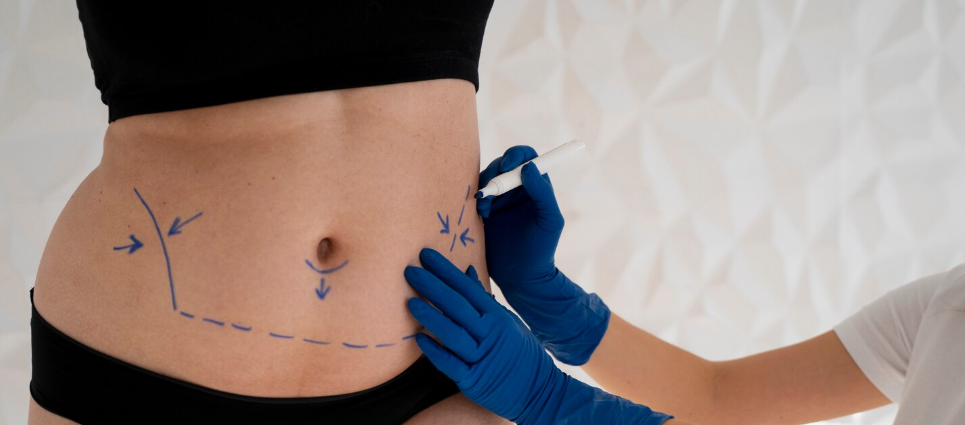Treatment Overview
Hip Line Contouring in Korea is a cosmetic procedure designed to reshape and refine the hip and waist area for a more balanced, feminine, and attractive silhouette. Depending on the patient’s needs, this may involve liposuction to reduce excess fat, fat grafting (hip dip filling) to enhance curves, or a combination of both. The goal is to achieve smoother transitions between the waist, hips, and thighs, correcting flat or uneven hip lines while accentuating the waist-to-hip ratio.
Korean plastic surgeons are well-known for their artistic approach to body contouring and use of advanced technologies such as micro-cannula liposuction, ultrasound-assisted fat removal, and precision fat grafting. Clinics in Korea often combine hip line contouring with 360° body liposuction, thigh contouring, or buttock augmentation to create a harmonious, hourglass figure.
Purpose & Benefits
- Hip Dip Correction: Fills in hip indentations for smoother curves.
- Waist-to-Hip Balance: Creates a more feminine hourglass silhouette.
- Fat Reduction: Removes stubborn fat from love handles or outer hips.
- Proportional Enhancement: Improves harmony between waist, hips, and thighs.
- Confidence Boost: Enhances body profile in dresses, jeans, and swimwear.
- Combination-Friendly: Often paired with tummy liposuction, thigh contouring, or buttock shaping.
Ideal Candidates
- Patients with hip dips, flat hips, or uneven hip contour.
- Individuals with stubborn fat deposits around the waist or outer hips.
- Adults in good health and at a stable weight.
- Patients who want a natural, feminine curve without exaggerated results.
- Non-smokers with realistic expectations.
Possible Risks & Complications
- Temporary bruising, swelling, or soreness.
- Numbness or mild sensitivity changes in treated areas.
- Uneven fat absorption in fat grafting (sometimes requiring touch-up).
- Rare risks: infection, fat embolism (with fat transfer), or asymmetry.
Techniques Used
- Liposuction: Removes fat from waist or outer hips for smoother curves.
- Fat Grafting (Hip Dip Filling): Injects purified fat into hip depressions to enhance shape.
- Hybrid Approach: Liposuction + fat transfer for the most natural contouring.
- Scar-Minimizing Entry Points: Very small incisions hidden in natural folds.
- 3D Body Analysis: Used in many Korean clinics for precise hip contour planning.
Recovery & Aftercare
- 1–2 weeks: Swelling and bruising subside significantly.
- Compression Garments: Worn for 3–4 weeks to support healing and contour.
- 3–5 days: Resume light walking and daily activities.
- 1–2 weeks: Return to desk work.
- 4–6 weeks: Resume moderate exercise (avoid intense lower body training early).
- 3–6 months: Final results visible after swelling and fat stabilization.
Aftercare Guidelines:
- Wear compression garments as directed.
- For fat grafting, avoid pressure on hips for 2–3 weeks to maximize fat survival.
- Maintain stable weight for long-lasting results.
- Follow scar-care treatments (if liposuction incisions used).
- Attend follow-up visits for contour and fat-graft evaluation.
Results & Longevity
- Smoother, rounder, and more defined hip lines.
- Improved waist-to-hip ratio and hourglass shape.
- Permanent fat removal (via liposuction).
- Long-lasting fat grafting results, with partial absorption in first 3–6 months.
- Natural results tailored to each patient’s body type.
Treatment Process in Korea
- Initial Consultation & Assessment
- Surgeons evaluate hip dips, fat distribution, and waist-to-hip balance.
- Plan created for liposuction, fat grafting, or hybrid treatment.
- Surgical Planning & Preparation
- Entry points for liposuction or grafting marked discreetly.
- Anesthesia: local with sedation for small cases, general anesthesia for full contouring.
- Procedure Day
- Liposuction performed with micro-cannulas for fat removal.
- Purified fat injected into hip dips or flat areas.
- Fine sutures used for discreet closure if needed.
- Post-Operative Monitoring
- Compression garment applied immediately.
- Most patients discharged same day.
- Follow-Up & Refinement
- Follow-ups at 1 week, 1 month, 3–6 months.
- Additional fat grafting touch-up may be recommended.
Why Korea is a Top Destination
- Surgeons specialized in hip dip correction and feminine silhouette design.
- Advanced fat grafting techniques for high fat survival rates.
- Use of micro-cannula and ultrasound-assisted lipo for precision.
- Customized approaches for natural, balanced curves.
- Affordable compared to Western countries, with premium quality and safety.
Cost Range
The cost of Hip Line Contouring in Korea varies depending on the method and clinic.
- Hip Liposuction Only: USD $3,500 – $5,500
- Fat Grafting (Hip Dip Filling): USD $4,500 – $6,500
- Hybrid (Liposuction + Fat Grafting): USD $6,500 – $9,500
- Extended Contouring (hips + waist + thighs): USD $8,500 – $12,000
- Premium Clinics (3D Imaging, VIP Aftercare, Advanced Scar Care): USD $9,500 – $14,000
Additional Costs:
- Consultation & imaging: USD $100 – $300
- Compression garments: USD $100 – $200
- Medications & aftercare: USD $100 – $250
Popular Clinics
- Banobagi Plastic Surgery (Seoul): Known for hip dip correction and natural fat grafting.
- ID Hospital (Seoul): Experts in body contouring and waist-to-hip reshaping.
- JK Plastic Surgery Center (Seoul): JCI-accredited, specializing in fat graft survival and scar minimization.
- View Plastic Surgery Clinic (Seoul): Leaders in hybrid contouring (liposuction + grafting).
- JW Plastic Surgery (Seoul): Customized hip contouring with natural, feminine proportions.




